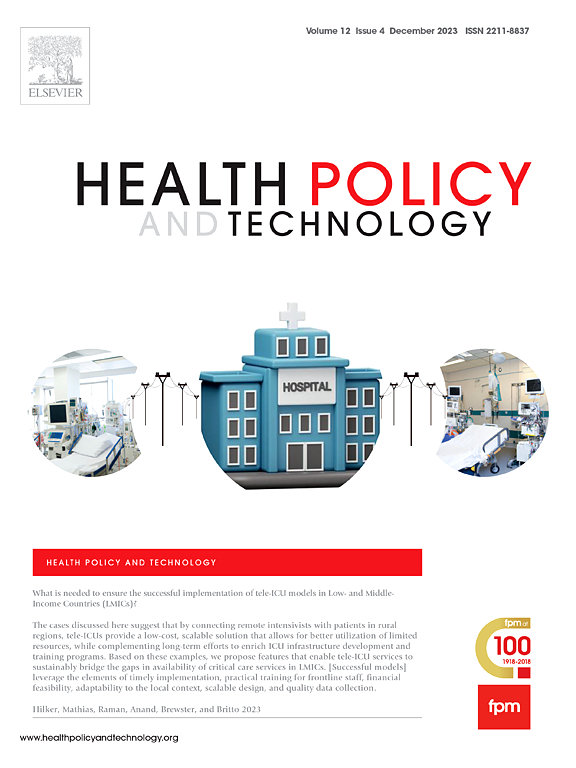2014-2022年中国养老服务资源配置效率与公平性研究
IF 3.4
3区 医学
Q1 HEALTH POLICY & SERVICES
引用次数: 0
摘要
背景随着中国老龄化进程的不断推进,合理配置养老服务资源的重要性和紧迫性日益凸显。本研究旨在对2014 - 2022年中国养老资源配置效率与公平性进行多维分析。方法采用三阶段数据包络分析对效率进行测度,采用贝叶斯线性回归和空间相关检验探讨效率的影响因素和空间效应。运用达格姆基尼系数分解法对公平性进行评估,考察差异的来源。结果2014 - 2022年,中国各省养老服务配置的平均效率呈上升趋势,从0.469上升到0.602。空间相关检验显示,省际效率值在空间上呈整体正相关,存在局部聚类现象。老年人福利的分配仍然不公平,区域间的差异是差距的主要来源。相反,床位数量、年终雇员人数和老年护理设施面积的分布仍然相对公平。养老机构和设施数量的分配从不公平过渡到适度公平。结论2014 - 2022年,中国养老服务资源配置整体效率较低,省际差异显著,空间效应明显。老年人福利分配不公平,主要是由于地区差异造成的。政策制定者应解决存在的区域差异,加强区域合作,科学规划养老服务资源投资规模和结构。本文章由计算机程序翻译,如有差异,请以英文原文为准。
Efficiency and equity of elderly care service resource allocation in China, 2014–2022
Backgrounds
As the aging process in China progresses, the importance and urgency of the appropriate allocation of elderly care service resources are becoming increasingly prominent. This study aims to provide a multidimensional analysis of the efficiency and equity of elderly care resource allocation in China from 2014 to 2022.
Methods
Three-stage data envelopment analysis was used to measure efficiency, while Bayesian linear regression and spatial correlation tests were employed to explore the influencing factors and spatial effects of efficiency. The Dagum Gini coefficient decomposition method was applied to assess equity and examine the sources of disparities.
Results
From 2014 to 2022, the average efficiency of elderly care service allocation in Chinese provinces showed an increasing trend, rising from 0.469 to 0.602. Spatial correlation tests revealed a global positive spatial correlation among provincial efficiency values, with local clustering observed. The allocation of elderly welfare remained inequitable, with inter-regional differences being the main source of disparities. Conversely, the distribution of bed numbers, end-of-year employee counts and elderly care facility areas remained relatively equitable. The allocation of elderly care institutions and facility numbers transitioned from inequity to moderate equity.
Conclusion
From 2014 to 2022, the overall efficiency of elderly care service resource allocation in China was relatively low, with significant inter-provincial differences and evident spatial effects. The allocation of elderly welfare exhibited inequity, primarily due to regional disparities. Policymakers should address the existing regional disparities, strengthen regional cooperation, and scientifically plan the scale and structure of investment in elderly care service resources.
求助全文
通过发布文献求助,成功后即可免费获取论文全文。
去求助
来源期刊

Health Policy and Technology
Medicine-Health Policy
CiteScore
9.20
自引率
3.30%
发文量
78
审稿时长
88 days
期刊介绍:
Health Policy and Technology (HPT), is the official journal of the Fellowship of Postgraduate Medicine (FPM), a cross-disciplinary journal, which focuses on past, present and future health policy and the role of technology in clinical and non-clinical national and international health environments.
HPT provides a further excellent way for the FPM to continue to make important national and international contributions to development of policy and practice within medicine and related disciplines. The aim of HPT is to publish relevant, timely and accessible articles and commentaries to support policy-makers, health professionals, health technology providers, patient groups and academia interested in health policy and technology.
Topics covered by HPT will include:
- Health technology, including drug discovery, diagnostics, medicines, devices, therapeutic delivery and eHealth systems
- Cross-national comparisons on health policy using evidence-based approaches
- National studies on health policy to determine the outcomes of technology-driven initiatives
- Cross-border eHealth including health tourism
- The digital divide in mobility, access and affordability of healthcare
- Health technology assessment (HTA) methods and tools for evaluating the effectiveness of clinical and non-clinical health technologies
- Health and eHealth indicators and benchmarks (measure/metrics) for understanding the adoption and diffusion of health technologies
- Health and eHealth models and frameworks to support policy-makers and other stakeholders in decision-making
- Stakeholder engagement with health technologies (clinical and patient/citizen buy-in)
- Regulation and health economics
 求助内容:
求助内容: 应助结果提醒方式:
应助结果提醒方式:


